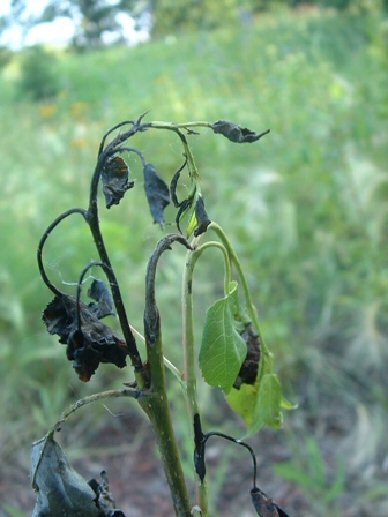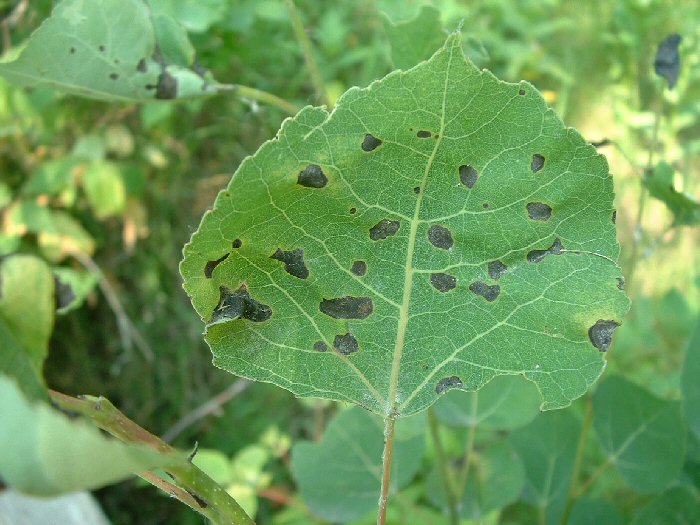Making it Tough to Straighten Out: Venturia Leaf and Shoot Blight of Poplar
An outbreak of this disease, in a new planting, can pose problems in establishing a central leader (single trunk) in woodlot operations if new shoot tips are repeatedly killed. Regenerating sprouts on recently cut trees can become quite distorted, resulting in crooked stems and poor canopy architecture.

Figure 1.
The blackened shoot tips and leaves of venturia leaf and shoot blight are the most obvious symptoms of this serious disease of poplar. Two species have been reported in Manitoba: Venturia moreletii and Venturia populina. Both can cause significant damage and symptoms from each are similar, but slight differences between them influence management. With the onset of the disease, infected tissues turn black and killed shoots droop and become brittle (See Figure 1).
All succulent leaves and shoots are susceptible to infection. Mature parts of the current year’s shoots and all parts formed in previous years escape infection. In other words, old growth is not affected directly by these pathogens. The fungi do not discriminate, attacking plants of all ages and sizes, potentially killing leaves and shoots throughout the crown. Generally the younger the stand, the greater the impact, as each individual shoot and leaf contributes a greater amount to growth of the plant relative to larger, well established trees.
The death of the leaf tips results in distortion of the leaves, but generally the leaf bases and petioles stay alive when V. populi is the pathogen. V. moreletii can infect petioles, turning them black.
During dormant seasons, damaged branches appear to be crowded, stunted and in varying states of decline (the result of the development of adventitious shoots and multiple leaders after death of terminal shoots). Canker causing fungi enter through blighted terminals and can contribute to the decline.


V. populi survives winters only on blighted shoots. V. moreletii survives on fallen leaves as well. Early season infections of new leaves from buds close to the infected and dead shoots begin the disease cycle and in as little as four days leaf symptoms (spots) may be observed. At least a week later, a new generation of leaf borne spores is produced, which give the lesions an olive-brown appearance. Wet periods with temperatures ranging from 15°C to 25°C, are suitable for infection to occur.
In Manitoba, the initial release of spores likely begins in late May or early June and subsequent cycles of infection continue into mid-July. After this point, the fungus prepares itself for winter survival and new spore releases cease until spring.
With few available management options this disease is a challenge to manage. Removal and destruction of blighted shoots is a good approach, but this may be difficult when the incidence of disease is high within a planting, and may not always be practical. Removal of leaf debris is a good approach regardless, but especially if V. populi is present, as this fungus overwinters on fallen leaves.
For further information, contact your GO representative.
